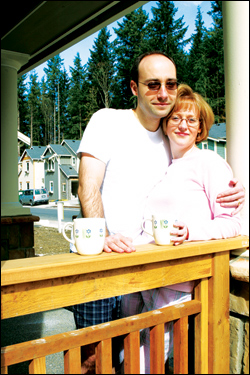TIME WAS, PEOPLE moving to the sticks were looking to escape neighbors and traffic and hubbub. Now hundreds of people are moving to a remote hilltop outside Redmond in order to live as if they were on Queen Anne—with close-in neighbors and dense housing stock; a diversity of ages and ethnicities; restaurants around the corner; recreational trails nearby; and, of course, traffic.
Redmond Ridge is a giant complex of apartments, condos, houses, and town homes, all plonked down on a formerly forested plateau far from even the Eastside’s urban centers. The development, which took 17 years to get permitted, welcomed its first resident in 2000 and is still being contested today. It represents a huge King County experiment in growth management and environmental awareness. The county is allowing a city with some 5,000 projected inhabitants to sprout in the middle of a sensitive rural area, with the hope that by concentrating so much growth in one project and strictly regulating how it’s built, the county can relieve the surrounding rural land from development pressure.
The result is a green-minded mini-city in the middle of nowhere, one of several such “master-planned communities” in the greater Puget Sound (such as Snoqualmie Ridge and Issaquah Highlands). By the time it’s completed, in 2005 or early ’06, Redmond Ridge will have 1,500 homes (and other development) on just 400 acres, with another 600 acres preserved as open space and parks. And that’s just phase one; phase two has not yet been approved.
MICROSOFTIE Allan Folting, 34, reserved a Redmond Ridge lot this past summer, not long after the company transferred him from Denmark and put him and his family up in a rental home at Redmond Ridge. “We thought we’d never like it,” he recalls. “We’re used to having a bit more space.” But ultimately the Foltings grew fond of the place. “The trees and trails are great for us,” says the father of two. “There’s so many kids. It kind of feels safe here.” Other Eastside tech employers have also surrounded him with a diverse group: Redmond Ridge has some 20 nations represented among its residents.
Sure, municipal planners love density. But isn’t this kind of lifestyle contrary to what the suburbs are all about? Evidently not, judging by the popularity of the project.
Since January, for instance, Eastside home builder CamWEST has sold 35 of the 48 semidetached homes it’s building in a Redmond Ridge subdivision called the Trails, which looks out on a greenbelt. Sized at under 2,000 square feet, most of the homes have zero lot lines and attach to the garage of the adjoining house. CamWEST has tried to make the density work by staying away from suburban uniformity and offering a mix of styles, materials, and rooflines. The shared walls, for instance, are disguised by staggering the homes, so that, as CamWEST’s sales vice president, Carolyn Gladwell, points out, “the garage doors are not in the same plane.”
The design, combined with the price—high $200,000s to high $300,000s—is helping draw young buyers. When Alison and Dusan Balic moved here from San Jose last year, they “didn’t want to go straight to the boonies,” says Alison, even though both she and her husband were working on the Eastside (she at Intel, he at Microsoft). Instead they took an apartment in Belltown. Then, with the couple planning to start a family, the boonies weren’t looking so bad, and the Trails had just what they were seeking. And the mandated density doesn’t faze them: “Growing up in Texas, planned communities were the norm,” says Alison. They’ll close on their house next month.
THE CORPORATE mastermind behind Redmond Ridge is Quadrant, the real-estate arm of Weyerhaeuser—which owned the land back when it was still forest. After almost two decades of challenges and debates, King County attached a host of requirements to the company’s final go-ahead: varied housing types (including some affordable to households with median area incomes); mandated density; and a slew of environmental restrictions. Quadrant, for instance, had to leave much of the site undeveloped and preserve large buffers around the site’s valuable wetlands.
As so often happens, though, onerous regulatory burdens have been transformed into key selling points, as the variously named subdivisions now heavily promote the amount of preserved green space—most of which, however, lies east of the home sites instead of between them. Even if residents aren’t exactly immersed in nature, the slogan for Redmond Ridge is “Inspired by Nature,” and the sales office, with its heavy timber construction and educational displays, looks more like a WPA-era National Park visitors’ center than a place for purchasing a condo. Kiosks posted around the development “let homeowners know they’re in an environmentally sensitive area,” says Bill Boucher, Quadrant’s head of communications; they explain such mysteries as “Where do birds go in the winter?” and “What is a wetland?” The official Web site offers tips on low-water gardening. The eco-friendly streets are noticeably narrower than in your typical subdivision—reducing the amount of water-shedding pavement as well as traffic speed.
How well is all this working? The project is nearly three-quarters built and occupied, and the county is pleased so far: Commenting on the storm drainage system, designed to return water to the underlying aquifer, it “would appear to be effective,” says King County’s Lisa Lee, who oversees compliance for Redmond Ridge. But she notes that a “very elaborate post-development monitoring system” is just getting under way; it will track water quality, streambed erosion, and other indicators. Green Brother is watching.
YET THE MOST controversial aspect of Redmond Ridge is not the hydrology but the massive amount of traffic it’s beginning to generate. The project was sold to the public and approved by the county as a “fully contained community,” which, among other things, means it’s supposed to offer close-by “jobs, housing, and services to the residents.” The idea is that not everyone has to drive 15 miles to the dry cleaners or for Chinese take-out, as in so much of the sprawling Eastside. But while that level of retail services exists now at Redmond Ridge—a few restaurants, a coffee bar, a gas station with quickie mart—it hardly seems enough to keep residents from the long ride to Fred Meyer. And as for non-Chevron employment: There is a 100-acre cleared lot that awaits someone who might want to build a business park at the remote spot. Any takers?
“If everybody lived and worked and walked around the same neighborhood, like they supposedly do in Europe, that would be great,” says City of Redmond planning director Roberta Lewandowski. But in reality, she says, “They all have to get to the highway.” As a result, downtown Redmond must contend with a growing daily crush of commuters trying to reach state Route 520. “We have to widen roads in areas that are environmentally sensitive,” she says. “The traffic through the rural area creates pollution.” A group of dogged area activists have contended for years, and with growing evidence, that King County low-balled the traffic estimates for Redmond Ridge in order to smooth Quadrant’s way to approval; they continue to pursue their claims with anyone who will listen. Public hearings on phase two are scheduled for August of this year.
Still, Lewandowski agrees that the fundamental strategy of allowing a large isolated development in order to secure surrounding rural zones seems to be working. “The county’s doing a good job of trying to protect the land” that lies outside the city limits, she says. Recent county numbers indicate that the vast majority of growth in King County over the last 10 years has occurred in the urban-designated areas, as policy makers and preservationists hoped.
And as for the traffic, well, that’s in the eye of the beholder. “We grew up in Houston,” says Alison Balic, “so traffic’s not an issue for us.”








